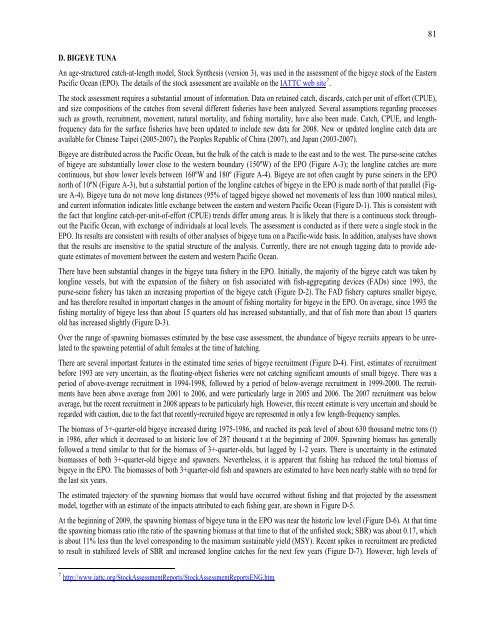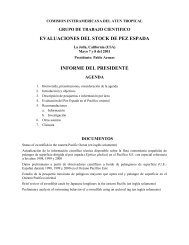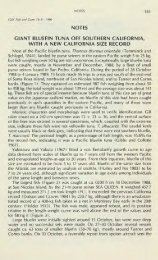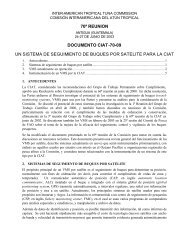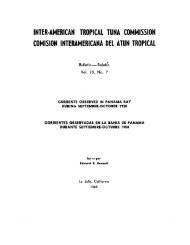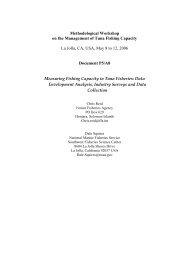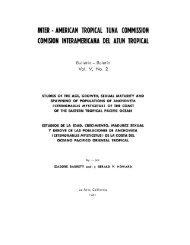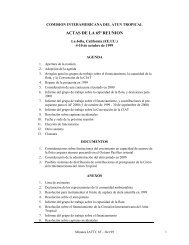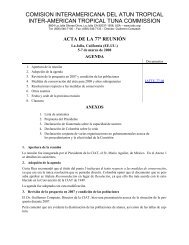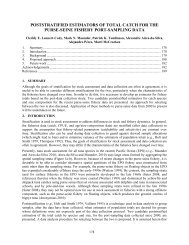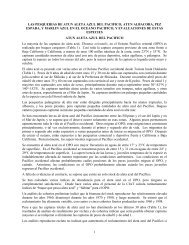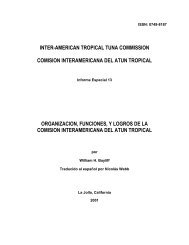INTER-AMERICAN TROPICAL TUNA COMMISSION - Comisión ...
INTER-AMERICAN TROPICAL TUNA COMMISSION - Comisión ...
INTER-AMERICAN TROPICAL TUNA COMMISSION - Comisión ...
- No tags were found...
You also want an ePaper? Increase the reach of your titles
YUMPU automatically turns print PDFs into web optimized ePapers that Google loves.
D. BIGEYE <strong>TUNA</strong>An age-structured catch-at-length model, Stock Synthesis (version 3), was used in the assessment of the bigeye stock of the EasternPacific Ocean (EPO). The details of the stock assessment are available on the IATTC web site 7 .The stock assessment requires a substantial amount of information. Data on retained catch, discards, catch per unit of effort (CPUE),and size compositions of the catches from several different fisheries have been analyzed. Several assumptions regarding processessuch as growth, recruitment, movement, natural mortality, and fishing mortality, have also been made. Catch, CPUE, and lengthfrequencydata for the surface fisheries have been updated to include new data for 2008. New or updated longline catch data areavailable for Chinese Taipei (2005-2007), the Peoples Republic of China (2007), and Japan (2003-2007).Bigeye are distributed across the Pacific Ocean, but the bulk of the catch is made to the east and to the west. The purse-seine catchesof bigeye are substantially lower close to the western boundary (150ºW) of the EPO (Figure A-3); the longline catches are morecontinuous, but show lower levels between 160ºW and 180º (Figure A-4). Bigeye are not often caught by purse seiners in the EPOnorth of 10ºN (Figure A-3), but a substantial portion of the longline catches of bigeye in the EPO is made north of that parallel (FigureA-4). Bigeye tuna do not move long distances (95% of tagged bigeye showed net movements of less than 1000 nautical miles),and current information indicates little exchange between the eastern and western Pacific Ocean (Figure D-1). This is consistent withthe fact that longline catch-per-unit-of-effort (CPUE) trends differ among areas. It is likely that there is a continuous stock throughoutthe Pacific Ocean, with exchange of individuals at local levels. The assessment is conducted as if there were a single stock in theEPO. Its results are consistent with results of other analyses of bigeye tuna on a Pacific-wide basis. In addition, analyses have shownthat the results are insensitive to the spatial structure of the analysis. Currently, there are not enough tagging data to provide adequateestimates of movement between the eastern and western Pacific Ocean.There have been substantial changes in the bigeye tuna fishery in the EPO. Initially, the majority of the bigeye catch was taken bylongline vessels, but with the expansion of the fishery on fish associated with fish-aggregating devices (FADs) since 1993, thepurse-seine fishery has taken an increasing proportion of the bigeye catch (Figure D-2). The FAD fishery captures smaller bigeye,and has therefore resulted in important changes in the amount of fishing mortality for bigeye in the EPO. On average, since 1993 thefishing mortality of bigeye less than about 15 quarters old has increased substantially, and that of fish more than about 15 quartersold has increased slightly (Figure D-3).Over the range of spawning biomasses estimated by the base case assessment, the abundance of bigeye recruits appears to be unrelatedto the spawning potential of adult females at the time of hatching.There are several important features in the estimated time series of bigeye recruitment (Figure D-4). First, estimates of recruitmentbefore 1993 are very uncertain, as the floating-object fisheries were not catching significant amounts of small bigeye. There was aperiod of above-average recruitment in 1994-1998, followed by a period of below-average recruitment in 1999-2000. The recruitmentshave been above average from 2001 to 2006, and were particularly large in 2005 and 2006. The 2007 recruitment was belowaverage, but the recent recruitment in 2008 appears to be particularly high. However, this recent estimate is very uncertain and should beregarded with caution, due to the fact that recently-recruited bigeye are represented in only a few length-frequency samples.The biomass of 3+-quarter-old bigeye increased during 1975-1986, and reached its peak level of about 630 thousand metric tons (t)in 1986, after which it decreased to an historic low of 287 thousand t at the beginning of 2009. Spawning biomass has generallyfollowed a trend similar to that for the biomass of 3+-quarter-olds, but lagged by 1-2 years. There is uncertainty in the estimatedbiomasses of both 3+-quarter-old bigeye and spawners. Nevertheless, it is apparent that fishing has reduced the total biomass ofbigeye in the EPO. The biomasses of both 3+quarter-old fish and spawners are estimated to have been nearly stable with no trend forthe last six years.The estimated trajectory of the spawning biomass that would have occurred without fishing and that projected by the assessmentmodel, together with an estimate of the impacts attributed to each fishing gear, are shown in Figure D-5.At the beginning of 2009, the spawning biomass of bigeye tuna in the EPO was near the historic low level (Figure D-6). At that timethe spawning biomass ratio (the ratio of the spawning biomass at that time to that of the unfished stock; SBR) was about 0.17, whichis about 11% less than the level corresponding to the maximum sustainable yield (MSY). Recent spikes in recruitment are predictedto result in stabilized levels of SBR and increased longline catches for the next few years (Figure D-7). However, high levels of817 http://www.iattc.org/StockAssessmentReports/StockAssessmentReportsENG.htm


